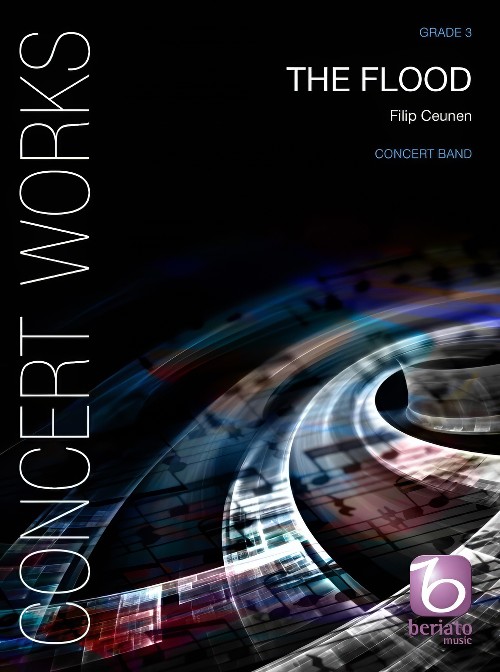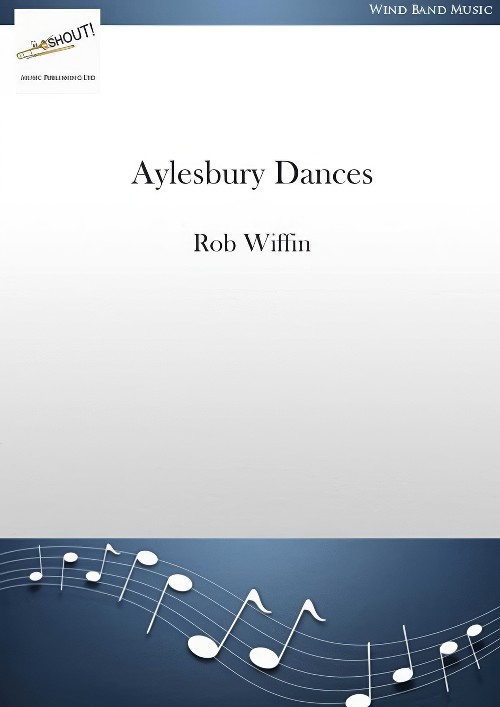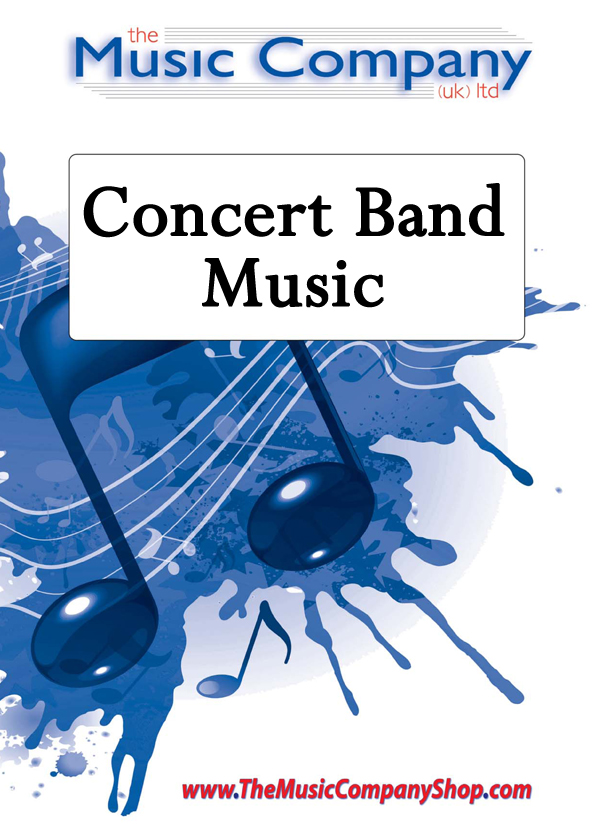Results
-
£54.99
Cupid's Call Valse - G. E. Holmes
Note: This is a reprint from a vintage publication of 1905. No conductor score is published for this work. The Solo Cornet part serves as a conductor guide.Due to the era of this work, saxophone parts are not published. Parts for Eb Horns are included; no F Horn parts are published for this work. If a C Piccolo/C Flute part was not published originally, one has been subsequently added by our editorial staff.
Estimated dispatch 7-14 working days
-
£53.95
Call to Glory - Elliot Del Borgo
This extensive, processional-like piece is an easy grade 2 and will work nicely as either a contest warm-up or impressive concert finale. Most of the low brass and woodwinds are scored together and the second clarinet remains below the break. Eb is the highest pitch for trumpet.
Estimated dispatch 7-14 working days
-
£78.99
To The Colors - Ronald C. Knoener
Written in the style of a U. S. Civil War marching song, this captivating little march features the historic flag-raising bugle call, "To the Colors." Delightful!
Estimated dispatch 7-14 working days
-
 £102.99
£102.99All the Best - Otto M. Schwarz
All the Best is a happy, upbeat piece by Otto M. Schwarz. He has already composed several pieces in this genre, including Fire & Ice, Last Call, and Funky Brass, and is constantly looking for ways to adapt new and interesting sounds and rhythms for concert band. All the Best will be a huge success with musicians and audiences alike, whether as a congratulatory piece, a concert-opener or as a rousing encore at the end of your concert.
Estimated dispatch 7-14 working days
-
 £137.99
£137.99The Roaring Forties - Philip Sparke
This new work by Philip Sparke was commissioned to celebrate the 40th anniversary of the Australian Army Bands Corps. The Roaring Forties is what seamen call the region between the 40th and 50th degrees of latitude in the southernhemisphere (due to the boisterous and prevailing westerly winds). A fanfare, chorale and an energetic vivo all capture this untameable region. Dur: 5:45
Estimated dispatch 7-14 working days
-
 £104.99
£104.99The Flood (Concert Band - Score and Parts) - Ceunen, Filip
The Flood was commissioned by Music Society Maris Sonores from Biddinghuizen, the Netherlands, on the occasion of its 55th anniversary. In this colourful composition, the name of the society has been inventively woven into the music, Maris Sonores meaning sounds of the sea, by means of key clicks in the flutes and clarinets, wind effects in various brass and woodwind instruments along with timpani, as well as sound effects in the small percussion. In addition, the history of the town is also reflected musically. Many centuries ago, around the year 800, a hamlet by the name of Bidningahusum already existed; unfortunately, it fell victim to the water of the then Zuiderzee. Later, the catastrophic flood of 1170 dealt the final blow. In the 1960s, there was a call for pioneers to once more build a town carrying the name Biddinghuizen in the polder of Eastern Flevoland - and so it happened. This versatile work has been written in such a way that many bands will be able to play it. Each instrument group comes out well, so that The Flood will be a joy for players and listeners alike. Duration: 9.30
Estimated dispatch 7-14 working days
-
 £104.99
£104.99The Flood - Filip Ceunen
The Flood was commissioned by Music Society Maris Sonores from Biddinghuizen, the Netherlands, on the occasion of its 55th anniversary. In this colourful composition, the name of the society has been inventively woven into the music - Maris Sonores meaning sounds of the sea - by means of key clicks in the flutes and clarinets, wind effects in various brass and woodwind instruments along with timpani, as well as sound effects in the small percussion. In addition, the history of the town is also reflected musically. Many centuries ago, around the year 800, a hamlet by the name of Bidningahusum already existed; unfortunately, it fell victim to the water of the then Zuiderzee. Later, the catastrophic flood of 1170 dealt the final blow. In the 1960s, there was a call for pioneers to once more build a town carrying the name Biddinghuizen in the polder of Eastern Flevoland - and so it happened. This versatile work, which is available for concert band as well as fanfare band, has been written in such a way that many bands will be able to play it. Each instrument group comes out well, so that The Flood will be a joy for players and listeners alike.
Estimated dispatch 7-14 working days
-
 £69.95
£69.95Aylesbury Dances (Concert Band - Score and Parts) - Wiffin, Rob
The suite Aylesbury Dances was commissioned by the Aylesbury Concert Band to mark the occasion of their 25th Anniversary in 2019. Its three movements depict different aspects of Aylesbury: I. Pavane: The Town - Having read something of the town's history and its architecture I decided I wanted to write something ceremonial with the feel of music from Tudor times. Aylesbury was given its charter and borough status in 1554 by Mary Tudor so I took that as my starting point but then added some harmony that moves forward in time. This fits with the town's motto: Semper Prorsum (Always forward) and also with the Band's evolution from Aylesbury Town Band to Aylesbury Community Concert Band to Aylesbury Concert Band. The music can be defined as a pavane, or a cortege. The sense of procession is slightly disturbed by a 'Blue Leanie' moment. The Blue Leanie is an iconic Aylesbury building, an oblique rhombic prism which stands at an angle of 17% inclination. I took a quaver out of the time signature (I know the maths don't work!) to reflect this and added some bluer harmony at that point. This opening movement gives a sense of the grandeur and heritage of Aylesbury town and a chance for my friends from the brass section to warm up! II. Siciliana: Waterside - To balance the outer two movements, the middle movement of the suite has a slow lilting 6/8 rhythm. It is in the style of a Siciliana, a dance form originating in the baroque era. It is a graceful, tender and melancholic dance, cast here in a minor key and featuring the dark voice of the cor anglais. The Siciliana was often linked with pastoral scenes and Aylesbury itself sits amid some beautiful countryside. It may, therefore, seem a bit of a stretch to call this movement 'Waterside', especially as Aylesbury is so far from the sea, but the town has a theatre of that name and that was the genesis for this particular music. There is a statue of Ronnie Barker in the grounds of the Waterside theatre as he started his career in repertory theatre in Aylesbury, so I included a fleeting reference to the theme music of the comedy programme 'Open all Hours'. III. Frolic: Ducks in a Row - It was impossible to write a piece connected with Aylesbury without considering the famous Aylesbury ducks. Duck rearing was a major industry in the town in the 19th century. The white Aylesbury Duck is a symbol of the town, appearing on its coat of arms and in the logo of the Aylesbury Concert Band! This movement is all about trying to get the little darlings in a row so they can sing their 'Duck Chorus' together but they keep on scattering, flying off or swimming away as quickly as they can manage. It's a bit like watching ducks disperse when my dog jumps into the stream after them. Eventually we get more of them in a row - even though they protest. Hidden amongst the ducks is a reference to Erica Miller, saxophonist and chairman of the band, and there's even a veiled reference to a shark in the hope of getting them out of the water. Ducks in a Row is a fun romp bringing this suite of Aylesbury Dances to a suitably celebratory conclusion.- Rob Wiffin.Duration: 9.15
Estimated dispatch 7-14 working days
-
 £65.00
£65.00Freyja's Call - Andrew Duncan
According to Viking mythology, following a battle the bravest souls of the slain would be divided between two Gods, Odin and Freyja. Freyja was the Goddess of Love and War and before going into battle many Viking warriors would pray that they would die bravely so that Freyja would take their soul to join her personal army made up of the souls of the bravest of men.'Freyja's Call' describes one of these, a young Scottish soldier, going into battle as part of the Viking army who occupied parts of Scotland for four centuries. First, a slow theme is heard, Freyja's theme, which is the soldier praying to Freyja to keep a watch on him. Then the drums introduce a new rhythm which announces the beginning of the battle.A Celtic Jig is used to describe the progress of the battle with the jig played quietly at first then gradually louder with more percussion being added until a full ff section signifies the soldier fighting the enemy directly.Suddenly, the music drops back to the quiet Jig theme. The soldier has been slain, but will he be chosen by Frejya? After a short time, Freyja's theme is heard as the brave soldier is taken to Freyja's heavenly army of brave warriors, and the piece then ends in triumph.
In stock: Estimated delivery 1-3 days
-
£39.95
Keep the Faith - Score and Parts - Duncan Stubbs
Program NotesKeep the Faith originally started as a personal tribute to my late mother. Not long after writing the opening ideas I was approached to write music to accompany a rendition of the poem "We Will Keep the Faith" by Moina Michael for performance as part of the 100th Anniversary of the start og World War I. The appropriateness of the music already written and the sentiment behind both concepts was a coincidence too good to overlook. Rarely sentimental and always practical I feel sure my mum would be delighted that the music she originally inspired was being used to portray a much wider universal message of remembrance.Whether performed with or without the poem a fully sustained sound should always be aimed for. The 'bugle' call at bar 20 and again at bar 76 should reflect a distant call across the trenches, the cornet remaining prominent over the upper woodwind. The tempo indication is a guide only and allowance must be made for the acoustic in which the piece is performed. The music must always flow, but appropriate rubato should be freely used together with appropriate tenuto in the middle of phrases.- Duncan Stubbs
Estimated dispatch 7-14 working days
